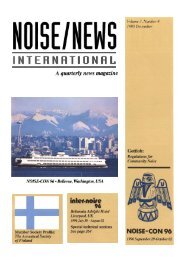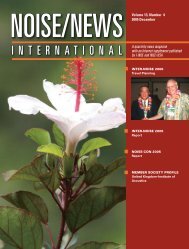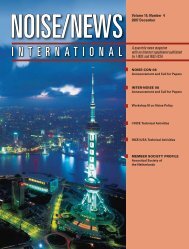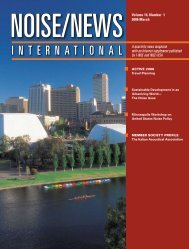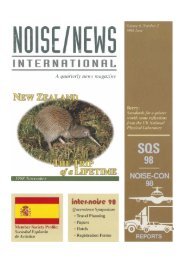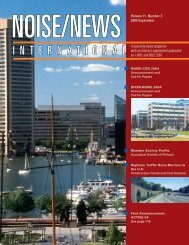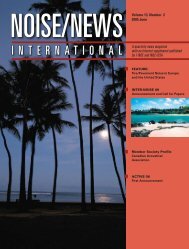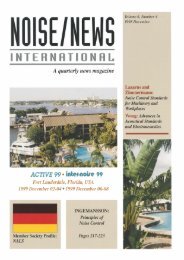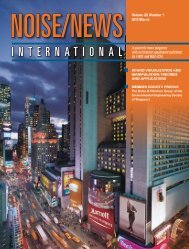Volume 14, Number 4, December, 2006 - Noise News International
Volume 14, Number 4, December, 2006 - Noise News International
Volume 14, Number 4, December, 2006 - Noise News International
You also want an ePaper? Increase the reach of your titles
YUMPU automatically turns print PDFs into web optimized ePapers that Google loves.
Editor’s View<br />
Quantifying the Cost of Hearing Loss<br />
I’m sure that every one reading this has at least<br />
one friend, colleague or family member who<br />
has a hearing loss. I’m also sure that for many<br />
of these, the hearing loss either results from or<br />
has been increased by, exposure to excessive noise at<br />
some time during their working life. Anyone working<br />
in the area of noise control engineering knows that<br />
there are engineering solutions for most excess<br />
noise situations in the workplace. But management<br />
may decide that the engineering solution may not<br />
be reasonable or feasible to implement. <strong>Noise</strong><br />
management then has to rely on the use of personal<br />
hearing protection, which has limitations.<br />
The decision about implementing an engineering<br />
solution is frequently made by management and<br />
based on the cost to the company of the work to be<br />
done or the changes to the workplace. However the<br />
cost to the individual and to society as a whole of<br />
hearing loss is rarely factored into this assessment.<br />
Two interesting reports have been produced in<br />
Australia that cast some light on this cost. One<br />
is a report entitled ‘Listen Hear!’ commissioned<br />
by the Cooperative Research Centre for Cochlear<br />
Implant and Hearing Aid Innovation (CRC HEAR)<br />
in partnership with VicDeaf (available at www.<br />
audiology.asn.au/pdf/ListenHearFinal.pdf).<br />
Council on “Work-Related <strong>Noise</strong> Induced<br />
Hearing Loss in Australia” (http://www.ascc.<br />
gov.au/ascc/HealthSafety/EmergingIssues/<br />
OccupationalDiseaseReports.htm). This is one of a<br />
series of studies to assist Government to set national<br />
action priorities to prevent occupational diseases.<br />
The study examined the workers’ compensation<br />
statistics for those coded with “sound and pressure”<br />
as the stated cause. It shows that the direct cost of<br />
those claims in 2001/02 was over 30 million AUD,<br />
and estimates that this is only 10% of the total cost of<br />
the loss of hearing. It is important to acknowledge<br />
that this data is only based on those who have made<br />
successful workers’ compensation claims and so only<br />
represents a proportion of the overall cost to society<br />
of noise induced hearing loss.<br />
Undertaking such studies to quantify overall costs of<br />
something like noise induced hearing loss is always<br />
difficult in view of the limited data bases upon which<br />
the conclusions must be drawn. Also there are many<br />
factors that can alter the statistics dramatically; for<br />
instance a small change in the criteria for assessable<br />
claims can make a difference in the amount of claims.<br />
However such studies clearly highlight that, even in a<br />
country that prides itself on providing good working<br />
environments, the cost to society of noise induced<br />
hearing loss is a substantial amount.<br />
Marion Burgess<br />
Asia-Pacific Editor<br />
The study reports that hearing loss ranks with asthma,<br />
diabetes and musculoskeletal diseases in terms of<br />
burden of disability, and should be considered as<br />
a national health priority. The report also found<br />
that 37% of this hearing loss is attributable to<br />
excessive noise exposure (all of which it considers<br />
preventable). Excessive noise in the workplace and<br />
social environments is not conducive to good hearing<br />
retention and the report recommends that approaches<br />
to better management of noise prevention are needed.<br />
If management were forced to factor into its<br />
calculations the total potential cost of noise induced<br />
hearing loss to the individual and to society it might<br />
affect the decision about whether an engineering<br />
approach to a noise control problem is reasonable<br />
and feasible.<br />
NNI<br />
A separate study has been undertaken by the<br />
Australian Government Safety and Compensation<br />
<strong>2006</strong> <strong>December</strong> www.inceusa.org • www.noisenewsinternational.net • www.i-ince.org<br />
133



